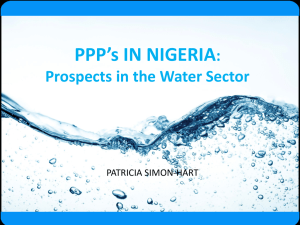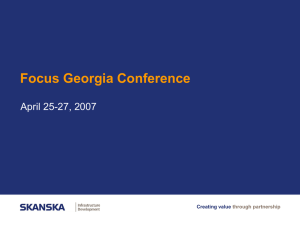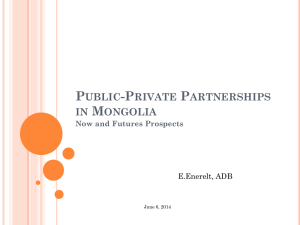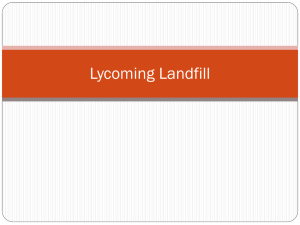IREX Webinar on PPPs
advertisement
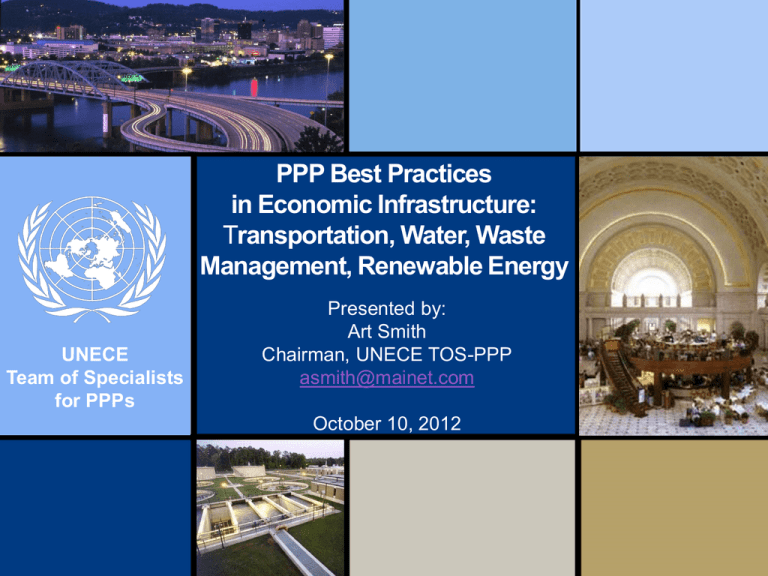
PPP Best Practices in Economic Infrastructure: Transportation, Water, Waste Management, Renewable Energy UNECE Team of Specialists for PPPs Presented by: Art Smith Chairman, UNECE TOS-PPP asmith@mainet.com October 10, 2012 2 Completed PPP Projects (U.S.) Union Station, Washington, DC JFK International Terminal 4, New York Port of Galveston, Texas Dulles Greenway, Virginia 3 Prioritizing and Balancing Objectives • Some objectives may be competing or mutually-exclusive. • For example, a government may wish to: − Provide drinking water from the tap at the lowest possible cost to consumers − Extend water availability to remote areas which currently lack service where the required investment may increase the cost to some or all consumers • For this reason, PPP objectives should be carefully assessed, prioritized, and balanced. 4 Project Objectives and PPP Contract Model Government Objectives: Solution: Provide a new road from point a to point b Relieve congestion Improve commuter access and reduce travel time Avoid government investment PPP Toll Road 5 Project Objectives and PPP Contract Model Government Objectives: Solution: Provide a new road from point a to point b Relieve congestion Improve commuter access and reduce travel time Avoid politically unpopular user fees PFI-type, availability-based payments 6 Vancouver Cogeneration Case Study • The City of Vancouver, British Columbia owns and operates one of the largest landfill sites in Canada. The site serves approximately 900,000 residents and receives approximately 400,000 tons of solid waste annually. • The site produces landfill gases as a byproduct of waste decomposition, including methane, a greenhouse gas that contributes to global climate change. • Since 1991, the City collected and burned (flared) the landfill gases to control odors and reduce the gases’ environmental impact. This burning created significant heat energy. In 2000, the City began to consider ways to make beneficial use of the landfill gases and heat energy, and to further reduce greenhouse gas emissions, in keeping with Canada’s commitment under the Kyoto Protocol. 7 Vancouver Cogeneration Case Study – cont. The City considered building a power plant itself to use the gas. They decided to solicit private proposals in order to evaluate a broader array of project concepts and maximize the economic, environmental, and social benefits to the City. The City decided to implement a Public-Private Partnership- based solution. It pursued a competitive tender process under which potential partners could propose their own solutions for the beneficial use of the landfill gas. A request for tender was released in January 2001, for a private partner to finance, design, build, own, and operate a beneficial use facility. Five varied proposals were received. 8 Vancouver Cogeneration Case Study – cont. Following a detailed and structured proposal evaluation and negotiation process, a 20-year Public-Private Partnership contract, based on the most highly-evaluated proposal, was approved by the City Council in February 2002. Under the approved PPP structure, the City continues to operate the landfill, and a 2.9 kilometer pipeline was constructed by the private partner to take the gas from the landfill to a nearby agricultural complex, where they built the cogeneration power plant. 9 Vancouver Cogeneration Case Study – cont. 10 Vancouver Cogeneration Case Study – cont. The private partner selected by the City designed, financed and constructed the cogeneration plant, which uses the landfill gas as fuel to generate enough electricity (7.4 MW per year) to supply 4,000 to 5,000 local homes. The power is sold by the private partner to a provincial utility, BC Hydro. Proceeds from the sales of power and thermal energy go to the private partner, minus a 10 percent royalty paid to the City. Waste heat from the power generation process is recovered as hot water, which is sold by the private partner to a large (32 acre) tomato greenhouse complex adjacent to the plant, where the water is used for heating purposes. 11 Vancouver Cogeneration Case Study – cont. • The City of Vancouver makes no payments to the private partner, but guarantees provision of landfill gases for the twenty-year duration of the PPP contract. • The private partner’s investment was approximately $10 million. • Construction of the power plant was completed in September 2003, and it was operating at full capacity by November of that year. (Initial capacity was 5.55 MW per year, increasing to 7.4 MW per year with the installation of a fourth engine in late 2004.) • Together, the power plant and greenhouse complex employ 300 people. 12 Vancouver Cogeneration Case Study – Outcomes • Instead of paying to flare the gas, the City now receives net revenues of $150,000 per year. • Using the landfill gases in this manner, rather than burning them, results in further reduction of greenhouse gases, equating to the removal of 6,000 vehicles from Canada’s roads. • New jobs and more available power were created for the greater Vancouver area. 13 Metropolitan Manila • Capital of the Philippines, metro area consisting of 17 separate municipalities • Population of over 14 million • Intensely congested in parts – second most populous country in S.E. Asia 14 Water and Wastewater Delivery • In the mid-1990’s, water and wastewater services in Manila were inadequately provided by the public utility • Less than two-thirds of the population had piped water. • Water was available, on average, 16 hours per day. • 63 percent of water was lost due to leaky pipes and illegal connections. • Only seven percent of the population connected to the sewage system. • More than 90 percent of sewage flowed untreated into Manila Bay. • Government utility hugely indebted: approximately $800 million. 15 Opportunity for a PPP? • The Philippine Build-Operate-Transfer (BOT) Law of 1993 enabled private sector participation in public works activities. • The Water Crisis Act of 1995 gave the President authority to establish a water/wastewater concession. • In August 1996, the government was forced to increase water rates by 38 percent in an attempt to keep the government-owned water company financially viable, but this was insufficient. 16 The Solution (?): A PPP • In 1996, the Metropolitan Waterworks and Sewage • • • • System (MWSS) began planning for a PPP. The Manila metropolitan area was split into two zones, east and west, to be run by two different concessionaires. The concession duration would be 25 years. After the concessions were awarded, MWSS would split into two entities, one to manage the concession agreements, and one to the be regulator. The concession agreements were awarded in 1997. 17 Government Objectives for the PPP Contracts: • Improvement in quality and efficiency of service. • Expansion of service. • Reduction in water tariff. • End expensive government subsidies. • Transfer debt to private partners. 18 East Zone Results Reduction in Non-Revenue Water (NRW) 70 65 63 60 55.2 55 53 NRW(%) 51 52 54 50.7 50 43.4 45 40 35.5 35 30 30 25.2 25 20 1997 1998 1999 2000 2001 2002 2003 2004 Year Source: Building Viable Water Utilities: The Manila Water Experience Virgilio C. Rivera, Jr., Group Director, Regulation and Corporate Development Manila Water Company, Inc. 2005 2006 Sep-07 19 East Zone Results Water Coverage 2007 1997 3.1 million (58% of population) Customer Base 5.6 million (99% of population) Availability of Water 16 Hours per Day 24 20 East Zone Results Manila Water Tariff Rates 25 Peso per cu. meter 20.48 20 2005 2006 13.88 14.02 15 9.37 10 5 18.55 19.72 4.02 4.37 4.55 4.77 1998 1999 2000 2001 0 2002 2003 2004 Year Source: Building Viable Water Utilities: The Manila Water Experience Virgilio C. Rivera, Jr., Group Director, Regulation and Corporate Development Manila Water Company, Inc. 2007



